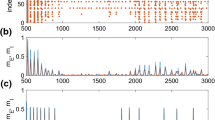Abstract
The main parts of the central olfactory system are the bulb (OB), anterior nucleus (AON), and prepyriform cortex (PC). Each part consists of a mass of excitatory or inhibitory neurons that is modelled in its noninteractive state by a 2nd order ordinary differential equation (ODE) having a static nonlinearity. The model is called a KOe or a KOt set respectively; it is evaluated in the “open loop” state under deep anesthesia. Interactions in waking states are represented by coupled KO sets, respectivelyKI e (mutual excitation) andKI i (mutual inhibition). The coupledKI e andKI i sets form aKII set, which suffices to represent the dynamics of theOB, AON, andPC separately. The coupling of these three structures by both excitatory and inhibitory feedback loops forms aKIII set. The solutions to this high-dimensional system ofODEs suffice to simulate the chaotic patterns of the EEG, including the normal low-level background activity, the high-level relatively coherent “bursts” of oscillation that accompany reception of input to the bulb, and a degenerate state of an epileptic seizure determined by a toroidal chaotic attractor. An example is given of the Ruelle-Takens-Newhouse route to chaos in the olfactory system. Due to the simplicity and generality of the elements of the model and their interconnections, the model can serve as the starting point for other neural systems that generate deterministic chaotic activity.
Similar content being viewed by others
References
Abraham RJ, Shaw CD (1983, 1985) Dynamics, the geometry of behavior. Ariel Press, Santa Cruz, CA, pp 220 (part 1), pp 137 (part 2), pp 121 (part 3)
Ahn SM, Freeman WJ (1974) Steady-state and limit cycle activity of mass of neurons forming simple feedback loops (I): Lumped circuit model. Kybernetik 16:87–91
Ahn SM, Freeman WJ (1974) Steady-state and limit cycle activity of mass of neurons forming simple feedback loops (II): Distributed parameter model. Kybernetik 16:127–132
Ahn SM, Freeman WJ (1975) Neural dynamics under noise in the olfactory system. Biol Cybern 17:165–168
Babloyantz A, Destexhe A (1986) Low dimensional chaos in epilepsy. Proc Nat 1 Acad Sci USA 83:3513
Conrad M (1986) What is the use of chaos? In: Holden AV (ed) Chaos. Manchester University Press, Manchester UK, pp 3–14
Freeman WJ (1962a) Alterations in prepyriform evoked potential in relation to stimulus intensity. Exp Neurol 6:70–84
Freeman WJ (1962b) Comparison of thresholds for behavioral and electrical responses to cortical electrical stimulation in cats. Exp Neurol 6:315–331
Freeman WJ, (1975) Mass action in the nervous system. Chap. 7. Academic Press, New York, p 489
Freeman WJ (1979a) Nonlinear gain mediating cortical stimulus-response relations. Biol Cybern 33:237–247
Freeman WJ (1979b) Nonlinear dynamics of paleocortex manifested in the olfactory EEG. Biol Cybern 35:21–37
Freeman WJ (1979c) EEG analysis gives model of neuronal template-matching mechanism for sensory search with olfactory bulb. Biol Cybern 35:221–234
Freeman WJ (1983) Dynamics of image formation by nerve cell assemblies. In: Basar E, Flor H, Haken H, Mandell AJ (eds) Synergetics of the brain. Springer, Berlin Heidelberg New York, pp 102–121
Freeman WJ (1985) Techniques used in the search for physiological basis for the EEG. In: Gevins A, Remond A, (eds) Handbook of electroencephalography and clinical neurophysiology, vol 3A, part 2, chap 18. Elsevier, Amsterdam
Freeman WJ (1986) Petit mal seizure spikes in olfactory bulb and cortex caused by runaway inhibition after exhausion of excitation. Brain Res Rev 11:259–284
Freeman WJ, Baird B (1987) Relation of olfactory EEG to behavior: spatial analysis. Behav Neurosci (in press)
Freeman WJ, Skarda CA (1985) Spatial EEG patterns, nonlinear dynamics and perception: the neo-Sherringtonian view. Brain Res Rev 10:147–175
Freeman WJ, Viana Di Prisco G (1986) EEG spatial pattern differences with discriminated odors manifest chaotic and limit cycle attractors in olfactory bult of rabbits. In: Palm G, Aertsen A (eds) Brain theory. Springer, Berlin Heidelberg New York
Garfinkel A (1983) A mathematics for physiology. Am J Physiol 245: (Regul. Integr. Comp. Physiol., 14, R445-R446
Holden AV (ed) (1986) Chaos. Manchester University Press, Manchester UK, p 324
Luskin MB, Price JL (1983) The topographic organization of associated fibers of the olfactory system in the rat, including centrifugal fibers to the olfactory bulb. J Comp Neurol 216:264–291
Rössler OE (1983) The chaotic hierarchy. Z Naturforsch 38a:788–801
Schuster HG (1984) Deterministic chaos. Physik, Weinheim, p 220
Scott JW, Ranier EC, Pemberton JL, Orona E, Mouradian LE (1985) Patterns of rat olfactory bulb mitral and tufted cell connections to the anterior olfactory nucleus pars extrema. J Comp Neurol 242:415–424
Shaw R (1984) The dripping faucet as a model chaotic system. Aerial Press, Santa Cruz CA, p 113
Shepherd GM (1972) Synaptic organization of the mammalian olfactory bulb. Physiol Rev 52:864–917
Author information
Authors and Affiliations
Additional information
Supported by a grant MH06686 from the National Institute of Mental Health
Rights and permissions
About this article
Cite this article
Freeman, W.J. Simulation of chaotic EEG patterns with a dynamic model of the olfactory system. Biol. Cybern. 56, 139–150 (1987). https://doi.org/10.1007/BF00317988
Received:
Accepted:
Issue Date:
DOI: https://doi.org/10.1007/BF00317988




